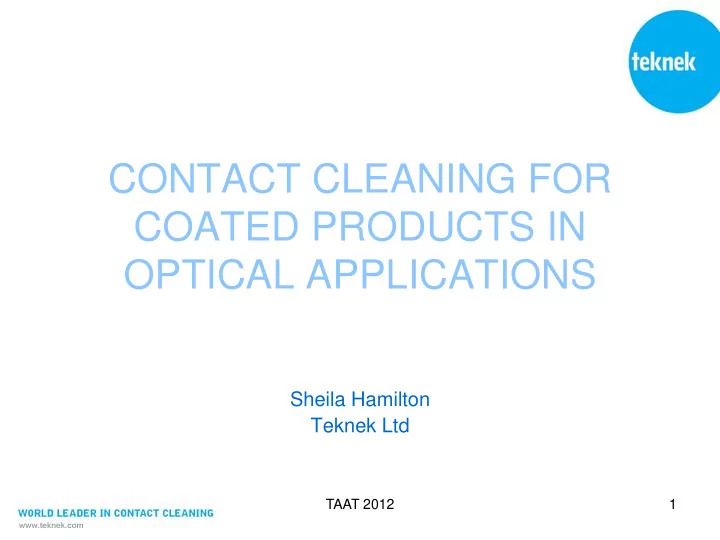

CONTACT CLEANING FOR COATED PRODUCTS IN OPTICAL APPLICATIONS Sheila Hamilton Teknek Ltd TAAT 2012 1
OUTLINE • Historical view of contact cleaning • Current market Drivers • Science of adhesion • Surface roughness analysis • Adhesion measurements • Other results • Conclusions TAAT 2012 2
CLEANING FUNDAMENTALS • Adhesive force between the elastomer roller and the particle must be greater than the force between the particle and the substrate • The adhesive force between the particle and the adhesive must be greater than that between the elastomer roller and the particle TAAT 2012 3
HISTORICAL VIEW • Softer rollers have greater contact area • Softer rollers clean better • Soft rollers deform around particles • Glossy rollers are smooth • Smooth rollers clean better TAAT 2012 4
MARKET DRIVERS • Thinner films • Increased processing of sheets • Specialist functional coatings • Structured films eg prism films • Static generative materials • Unbalanced surfaces TAAT 2012 5
SHORE HARDNESS 80 70 60 50 Holding capacity 40 Shore 30 20 10 0 1 2 3 4 5 6 7 8 9 10 11 12 13 14 15 16 17 18 19 20 21 22 23 24 25 TAAT 2012 6
INTERFACIAL FORCES TAAT 2012 7
EXAMPLES OF ADHESION FORCES TAAT 2012 8
MACRO ADHESION RUBBER COPPER STEEL Cu/KAPTON POLYESTER POLYCARBONATE (Gloss) (Matt) 1.17 3.26 0.51 2.55 2.37 SOFT 1.49 3.32 0.81 2.63 1.07 PANEL 0.63 0.81 0.34 1.68 1.4 FILM 0.11 0.11 0.11 0.05 0.12 F3 0.08 0.04 0.07 0.75 0.34 NANO TAAT 2012 9
CONTACT AREA Contact area is impacted by • Roller surface roughness • Pressure • Shore hardness • Particle morphology TAAT 2012 10
SURFACE ROUGHNESS Scan Size 1 2 3 Sample name Soft 2.169 11.143 38.582 Panel 7.355 13.493 23.467 Nanoclean 3.616 1.400 6.292 Film 7.453 16.861 18.54 F3 31.009 49.085 98.334 TAAT 2012 11
SURFACE OF SOFT ELASTOMER TAAT 2012 12
SURFACE OF PANEL ELASTOMER TAAT 2012 13
SURFACE OF F3 ELASTOMER TAAT 2012 14
SURFACE OF NANOCLEEN ELASTOMER TAAT 2012 15
SURFACE ROUGHNESS TAAT 2012 16
SUMMARY • For small particles surface roughness has to be considered on a microscopic scale • Ideally surface asperities should be matched to the size of the particle of contamination • The flexibility of the roughness peaks is important. TAAT 2012 17
FORCE DISPLACEMENT CURVES • Gold TAAT 2012 18
FORCE DISPLACEMENT CURVES • Polystyrene TAAT 2012 19
FORCE DISPLACEMENT CURVES • Silica TAAT 2012 20
ADHESION FORCES Type of Probe Silica Gold-coated silica Polystyrene Sample name Soft 752.08 ± 147.06 951.87 ± 69.48 1027.79 ± 109.82 Panel 848.11 ± 112.98 823.55 ± 160.72 847.12 ± 214.75 Nanoclean 803.08 ± 443.79 285.14 ± 161.34 1073.17 ± 629.94 Film 866.80 ± 144.75 1152.12 ± 125.74 1177.89 ± 81.77 F3 1076.98 ± 420.92 746.64 ± 329.49 813.09 ± 393.31 TAAT 2012 21
ADHESION FORCES • Panel and soft and film TAAT 2012 22
ADHESION FORCES • F3 and Nanocleen TAAT 2012 23
SUMMARY • Hydrophobicity of materials is important for adhesion • Adhesion on the macro scale does not relate to the micro scale • Surface roughness on a micro scale causes variations in the adhesion forces TAAT 2012 24
CONCLUSIONS • Moisture affects cleaning performance • Good cleaning improves wettability • Lot more experimentation required TAAT 2012 25
ACKNOWLEDGEMENTS • Dr Zhenyu (Jason) Zhang and Professor Mark Geoghegan of the Polymer Institute at The University of Sheffield for help with the testing. TAAT 2012 26
Recommend
More recommend